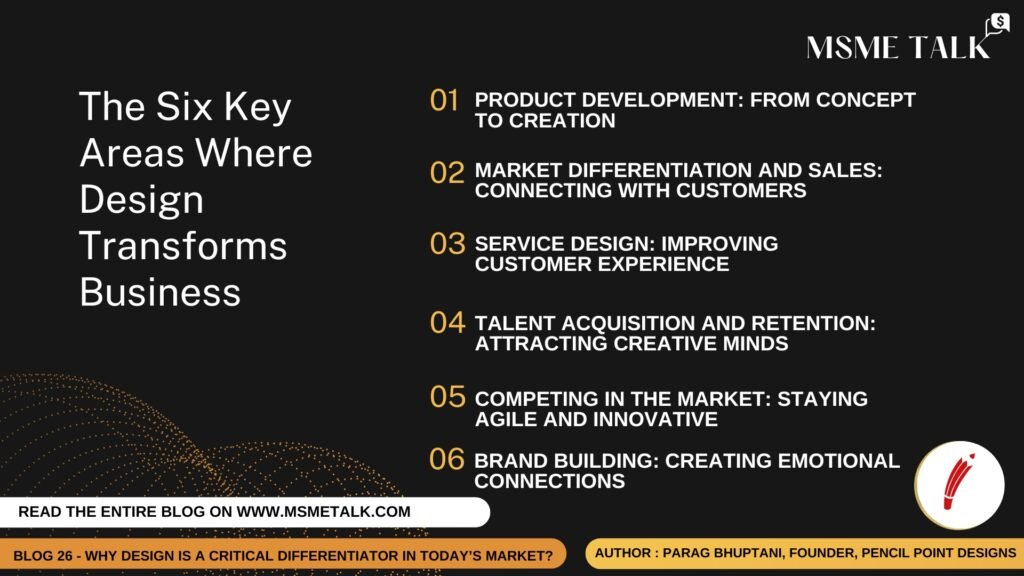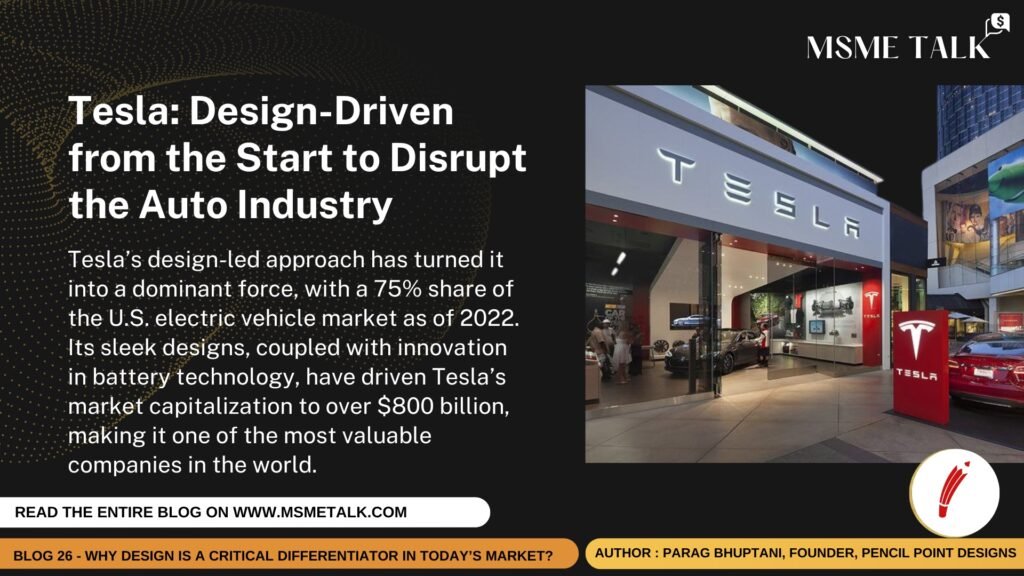Contents
ToggleBLOG 26 - Why Design is a Critical Differentiator in Today’s Market?
In this blog, an Author who is a Design Expert guides us how design is used in key areas for building strong businesses. It shapes products, strengthens brands, enhances customer experiences, boosts sales, attracts top talent, and fuels innovation. With examples from companies like Tesla, this blog highlights how a design-driven approach leads to business success, customer loyalty, and a competitive advantage.
You may want to check the previous blog, Blog 24- Design in Business : Impact on Growth and Financial Success, in which author has shared how design thinking helps businesses grow and improve their financial success discussing case study of the leading companies like Nike and Tata Group which have leveraged design to create distinctive products, build strong brands, and drive long-term success.
(Subscribe for alerts to stay updated with new podcast episodes and blogs for MSMEs & Startups)
About the Author
Parag Bhuptani, Founder and Chief Design Strategist at Pencil Point Designs. He brings over two decades of global experience in strategy and design services, helping clients build distinct and differentiated brands.

Introduction
With businesses constantly adapting to new challenges and opportunities, companies are no longer competing solely on price, technology, or operational efficiency—design has become a critical differentiator. More than just aesthetics or branding, design has emerged as a strategic force that drives innovation, customer engagement, and business success.
So what makes design such a powerful business tool? It’s because design is not just about what something looks like—it’s about how it works, how it feels, and how it solves real problems. A well-designed product creates an intuitive and enjoyable experience. A thoughtfully designed service makes customer interactions seamless and effortless. A strong, design-driven brand builds trust, emotional connection, and loyalty. And a company that integrates design thinking into its culture fosters creativity, agility, and long-term innovation.
In this blog, I will be discussing the transformative power of design in six key areas of business :
- Product Development: How design shapes products from concept to reality.
- Market Differentiation & Sales: The role of design in branding, storytelling, and customer engagement.
- Service Design: How businesses improve customer experiences through design thinking.
- Talent Acquisition & Retention: The role of design in attracting and nurturing top creative talent.
- Agility & Innovation: How design thinking helps businesses stay adaptive and competitive.
- Brand Building: How companies use design to create emotional connections and long-term customer loyalty.
Through real-world example, we’ll see how businesses across various sectors use design to stay ahead of the competition, enhance customer satisfaction, and build lasting brand equity.
Let us discuss in detail, how design transforms key aspects of business.
The Six Key Areas Where Design Transforms Business

1. Product Development: higher successful products
Human Centric approach :Design plays a critical role in transforming the way companies develop their products. Conscious Design brings focuses on functionality or technology, along with a human-centered approach to product development.
By putting the customer at the heart of the process, companies can create products that not only meet technical specifications but also resonate with users on an emotional and practical level. This approach leads to products that are more intuitive, user-friendly, and better suited to solving real world problems. Companies like Apple and Dyson have famously used design to redefine product categories by combining cutting-edge innovation with a deep understanding of user needs.
2. Market Differentiation and Sales: Connecting with Customers
Emotional Connect & impactful Communication :In a crowded marketplace, design offers a key differentiator that sets businesses apart from their competitors. It shapes not only the product itself but also how it is presented to consumers.
Through design thinking, companies can craft compelling marketing campaigns that tell a cohesive story, connect emotionally with their audience, and communicate the value of their product or service in a way that resonates. Whether it’s through striking visuals, seamless user interfaces, or immersive customer experiences, design helps businesses capture attention, build trust, and ultimately drive sales.
Furthermore, design-driven companies are able to market more effectively by creating strong, consistent brand identities. Visual design, branding, and packaging all contribute to how consumers perceive a product. A well-designed brand identity can communicate values, create emotional connections, and inspire brand loyalty, making design an essential component of marketing success.
3. Service Delivery : Improving Customer Experience
Design in Customer interaction : Beyond products, service design transforms customer interactions by improving every touchpoint.
By mapping out customer journeys and identifying pain points, businesses can reimagine the way they deliver services to create a more seamless and enjoyable experience. This can be seen in industries ranging from retail to healthcare, where service design ensures that every customer touchpoint—from the first interaction to post-purchase support—delivers value and satisfaction. Improved customer experiences lead to higher satisfaction, increased retention, repeat customers and stronger word-of-mouth marketing.
4. Talent Acquisition and Retention: Attracting Creative Minds
Designing Culture : Companies that prioritize design cultivate environments that are more innovative, collaborative, and dynamic.
This attracts creative talent who want to work in dynamic, forward thinking workplaces. By integrating design into their operations, these businesses foster a culture of creativity and innovation, empowering employees to think critically, challenge norms, and bring fresh ideas to the table. Design-driven companies such as Google and IDEO are known for their ability to attract top talent who are motivated by the opportunity to engage in meaningful, design-led work.
Moreover, the influence of design extends beyond product teams; it affects how companies structure their organizations and develop internal processes. Design thinking encourages cross-functional collaboration, breaking down silos and encouraging teams from various departments—marketing, sales, engineering, and customer service— to work together in creating cohesive, customer-centered solutions.
(Subscribe for alerts to stay updated with launch of new blogs/podcast episodes about MSMEs & Startups)
5. Agility & Innovation: Staying Competitive in a Fast-Changing Market
Designing continuous innovation and agility :Design thinking enables businesses to remain agile and responsive to changing market demands.
Design thinking, with its focus on rapid prototyping, user feedback, and iterative improvement, enables companies to remain agile. Instead of spending years perfecting a product before it reaches the market, businesses can use design to quickly launch, learn, and improve based on real user insights. This cycle of continuous improvement allows companies to stay ahead of the curve, innovate faster, and respond more effectively to changing market conditions.
Additionally, design enables companies to tackle complex business challenges with creative solutions, driving innovation not just in products but also in business models, customer experiences, and operational processes. Whether it’s developing a new product category or finding more sustainable ways of operating, design encourages businesses to think outside the box and find innovative ways to compete.
6.Brand Building: Creating Emotional Connections & Loyalty
Designing customer loyalty :A company’s brand is its most valuable asset, and design plays a central role in shaping how that brand is perceived by the world.
Through visual identity, storytelling, and customer experience, companies can craft a brand identity that resonates emotionally with consumers. A strong brand creates trust, fosters loyalty, and drives long-term business success. Design enables businesses to craft a consistent and compelling brand narrative that aligns with their values, vision, and the needs of their target audience.
Companies like Nike, Coca-Cola, and Tesla have mastered the art of design-driven branding,that evoke strong emotions and remain relevant in consumers’ lives. Their design strategies go beyond logos and packaging—they extend to every aspect of the customer experience, from advertising to product design to retail environments. This comprehensive, design-led approach to brand building has a lasting impact on customer loyalty and market dominance.
Case Study: Tesla – A Design-First Approach Revolutionizing the Auto Industry

Tesla: A Design-Driven Company from the Start
When & How: Tesla embraced a design-first mindset from its inception in 2003, with Elon Musk pushing for an all-electric vehicle that was both high-performance and visually stunning. The design of the Tesla Model S in 2012 set a new standard in automotive design, focusing on user experience, minimalism, and cutting-edge technology.
Before Tesla’s Design Focus
Tesla, as a startup, faced skepticism about the viability of electric vehicles, with concerns about performance and adoption.
After Tesla’s Design Innovation
A Tesla vehicle is a design marvel. From vehicle styling to the software that runs the car to innovation in battery technology – everything is thoughtfully designed. When one sees the features like ‘Fetch’ where one can fetch the car from a parking lot from one’s mobile phone and see it in action where it carefully navigates the traffic within the legal speed limit, one feels the car is very much alive. It is a delightful experience. And this is just one of the many intelligent and useful features like dancing demo, self-drive, funny sounds etc. All of these combined have driven Tesla’s market capitalization to over $800 billion, making it one of the most valuable companies in the world.
The Business Impact of Design
All three companies—Nike, Tata Group discussed in a previous blog and Tesla in this blog—show how embracing design transforms not just products, but brand perception, customer loyalty, and financial performance. Each company’s pivot to a design-centric culture resulted in significant revenue growth, market share expansion, and global recognition, offering compelling evidence for investors and senior management to prioritize design thinking in their strategic initiatives.
Conclusion: Why Businesses Must Prioritize Design
The transformative power of design is evident in every aspect of business—from product development to marketing, customer experience to talent acquisition. Companies that embrace design as a central element of their strategy are not only more innovative and agile but also better equipped to meet the needs of their customers and adapt to the evolving market. By integrating design thinking into the very fabric of their organizations, businesses can unlock new growth opportunities, differentiate themselves from competitors, and build lasting brand equity.
This blog is authored by Parag Bhuptani, Founder and Chief Design Strategist at Pencil Point Designs. He brings over two decades of global experience in strategy and design services, helping clients build distinct and differentiated brands. Know more about his firm through his profile.
(Subscribe MSME TALK for alerts to stay updated with new podcast episodes and blogs by experts for MSMEs & Startups)
MSME TALK is now available on Youtube also

Comments